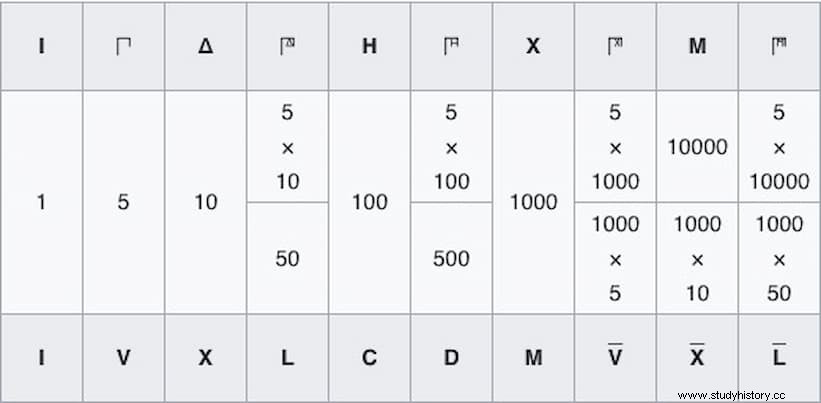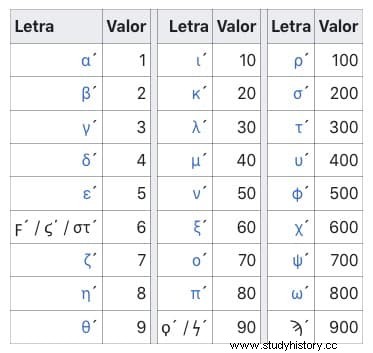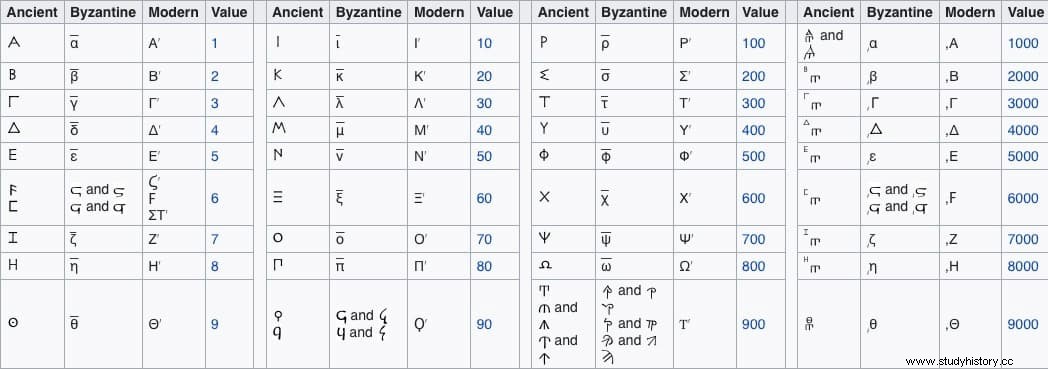Everyone knows how the Romans wrote numbers. It is not a very complicated system, at least until it comes to representing very high numbers, because they did not have decimals or negative numbers among other things.
In essence, an I represents 1, a V represents 5, an X represents 10, an L represents 50, a D represents 500, and an M represents 1000.
Combining them we can form any number, bearing in mind that depending on their position they can add or subtract, and that to represent very large numbers new symbols must be introduced, as we saw a long time ago in another article.

The Roman system derived from the Etruscan and, through it, from the Greek. But how did the ancient Greeks write numbers?
Well, they had two forms, the oldest of which is the Attic numeration or acrophonic system, that is, based on the initial letters of the words of the numerals. The other is called the milesian system , and is still in use today.
Attic numeration
It was used in all public inscriptions in Attica from the 7th to the 1st century BC. And also in most other Greek cities between the 5th and 3rd centuries BC, when it was replaced by the Milesian system.

It is called acrophonic because the numbers took their name, except 1, from the first letter of the word used to name the numerals. Thus, Ι =1, Π =5, Δ =10, Η =100, Χ =1,000, and Μ =10,000.
Which derived from πεντε (pénte , five), δεκα (déka , ten), ηεκατον (hekaton , hundred), χιλιοι (chílioi , thousand), and μυριας (myrías ten thousand).
To represent the numbers 50, 500, 5000 and 50000, the letter pi was used with the corresponding power of 10 in its right corner. For example, 2021 was written XXΔΔI, and 49 =ΔΔΔΔΠΙΙΙΙ.

The Milesian system

It developed in the city of Miletus, located in Ionia on the western coast of the Anatolian peninsula, in the 5th century BC. and then it was replacing the attic system in practically all Greek cities.
It is a quasi-decimal alphabetic system, in which each figure is assigned a letter of the Ionian Greek alphabet, with the particularity that the tens and hundreds are not created by addition but also have a particular letter assigned.
The 24 letters established by the mathematician Euclid are used, plus another three of Phoenician and Ionian origin that were not added to the Greek alphabet:digamma (Ϝ) for 6, koppa (ϙ) for 90 and sampi (Ϡ) for the 900.
To distinguish the numbers from the letters that form the words, the numerals had a bar above or an acute accent at the end.
The numbers are formed by addition, adding the value of all the letters to obtain the total result. For example, the number 753 would be ψνγ’.

From the number 1000, the same unit letters, tens and hundreds are used again, but adding an inverted acute accent or a comma at the beginning, to distinguish them from numbers of lower value. Thus, 2021 would be ͵βκα’.
Numerals were written both in lowercase and uppercase, and in some cases they appear in reverse order, that is, from right to left. Also, over time some letters were replaced, like the koppa , or simplified as the digamma .

In Ancient Greece there was no symbol to represent the number 0, which would not be introduced until the Hellenistic era, but fractions were represented.
A half was represented by a semicircle open to the right, while a quarter was represented by a semicircle open to the left, both in the Attic system, while in Milesian an acute accent at the end of each letter indicates the fraction. For example, δʹϛʹ =1/4 + 1/6 =5/12.
The Milesian system is still in use today in Greece, along with Western Arabic numerals.
